Parisian Walkways: Rue Dauphine on the Left Bank
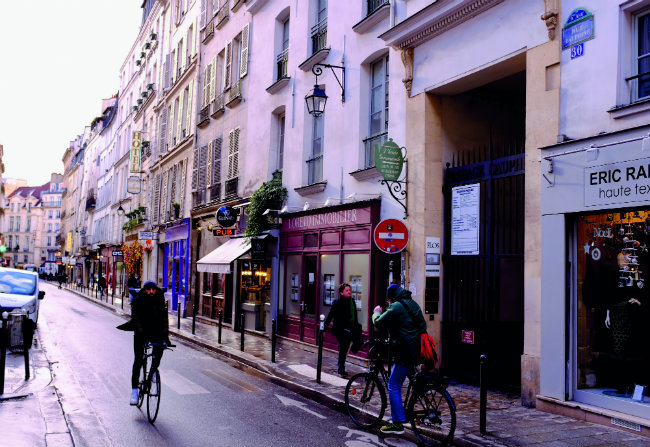
After the Pont Neuf runs onto the Left Bank, a characterful street continues its course into Saint-Germain-des-Prés. Jeffrey T Iverson meets the people who work there…
If there is one place and time which stirs the collective imagination of Francophiles like no other, it must surely be Saint-Germain-des-Prés and post-war Paris. Agnès Poirier’s captivating 2018 book, Left Bank: Art, Passion, and the Rebirth of Paris, 1940-50, rekindles our fascination for this period when a small area of the Left Bank with decrepit hotels and cheap cafés became for a time the intellectual and artistic capital of the world.
“After four years of Nazi occupation and daily torment, Paris’s galleries, boulevards, jazz clubs, bistros and bookshops became forums for heated discussions, battle plans and manifestos,” writes Poirier. “Those young men and women, budding novelists, philosophers, painters, composers, anthropologists, theorists, actors, photographers, poets, editors, publishers and playwrights, shaped by the ordeals of World War II, promised to themselves to re-enchant a world left in ruins.” This they did. Yet today, one sometimes wonders if anything remains of the world they created.
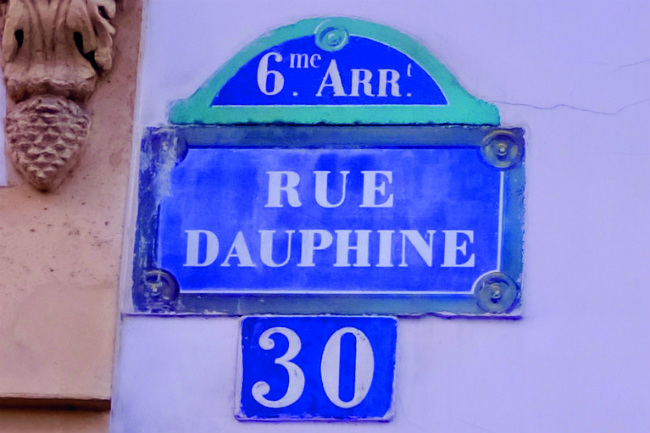
The rue Dauphine. Photo: Jeffrey T Iverson
Over time, as the 6th arrondissement became one of the most fashionable, most expensive districts of Paris, a lot of that artistic and literary spirit seems to have been lost. Sky-rocketing rents have forced out young artists and the most avant-garde gallerists, and contributed to the closure of scores of publishers, bookstores and jazz clubs. Yet if one ventures a few steps off the boulevard Saint-Germain into the tangle of narrow streets that constitutes the most ancient quartier of the district, there’s a place that, amid all the challenges and evolutions of the present, has retained a fair bit of that spirit of the past: a colourful street named rue Dauphine.
In 1947, a club was inaugurated at the corner of rue Dauphine and rue Christine that became more than just another bar: Le Tabou. For novelist, poet, playwright and jazz trumpeter Boris Vian it was “a veritable sanctuary for the new generation”. Perhaps the most mythic jazz club of post-war Saint-Germain-des-Prés, Le Tabou was the after-midnight hangout for the poets, painters and philosophers from Café de Flore and Les Deux Magots, and all the young zazous who wanted to dance the night away. Sartre, De Beauvoir, and Cocteau were regulars. Juliette Gréco played MC, sang and read poetry, while Boris Vian directed the jazz band and Gréco’s lover, Miles Davis, added his trumpet to the mix. As Vian later recalled, “Le Tabou evolved into a centre of organised madness. No club that followed was ever able to recreate this incredible atmosphere, and even Le Tabou itself couldn’t keep things going like that for ever”.
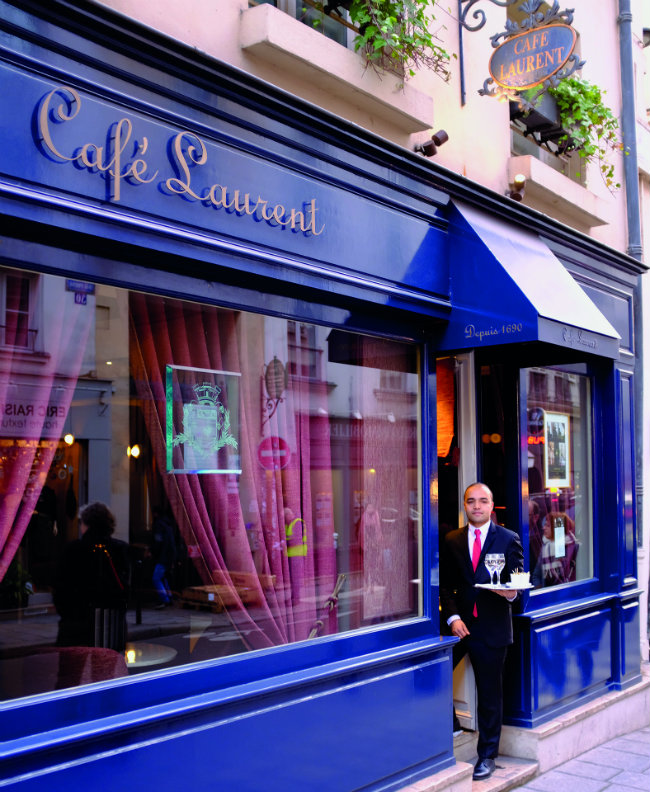
Café Laurent at the Hotel d’Aubusson. Photo: Jeffrey T Iverson
Yet even after the existentialists had migrated elsewhere, Le Tabou remained a jazz club where masters like saxophonist Lester Young and trumpeter Clifford Brown performed. Le Tabou is no more, but that rich history has continued to inspire jazz lovers to make pilgrimages to Saint-Germain-des-Prés. Many are disappointed when they realise that the music has mostly quit the Left Bank for clubs across the river like New Morning and Duc des Lombards. But today, if you take an evening stroll down rue Dauphine and pause before the commemorative plaque at No.33, hung in honour of Le Tabou, you might get a shock when you hear… jazz in the air!
In 2000, the management of the luxurious Hôtel d’Aubusson decided to give a new vocation to their bar, Café Laurent, at 33 rue Dauphine, which a half century before had been Le Tabou. “At a time when the jazz clubs of Saint-Germain-des-Prés were disappearing, there was desire here to keep this tradition alive,” says pianist Christian Brenner, who programmes the Café Laurent’s weekly jazz concert series. “And that’s what we continue to work for.” Growing from a piano bar to a six-night-a-week venue for vocal and instrumental jazz, the Café Laurent has become a veritable oasis for jazz in the quartier.
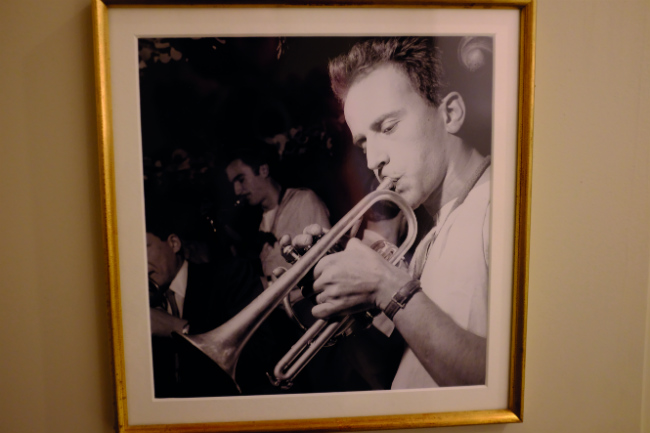
A vintage photo of Boris Vian at Café Laurent. Photo: Jeffrey T Iverson
“Everything changes at nightfall here,” says Audrey Blot, Hôtel d’Aubusson’s marketing director. “We have many regulars from the neighbourhood who come in the evening – authors, book merchants, publishers… They all gather here to share a drink, mingle and enjoy the jazz. There’s something special, a kind of osmosis that takes place here every night, completely separate from the hotel. It’s rather magical.”
The magic of Café Laurent is also that of rue Dauphine in general, a street where the layers of history can still be seen, heard and tasted. For a reminder of this, one can leave behind the plush atmosphere of the jazz bar, walk back past the zinc counter, and step into Hôtel d’Aubusson’s grand salon with its 17th-century stone fireplace and soaring ceilings supported by old wooden beams. Suddenly we’ve left the jazz era for the 1600s – the very century in which rue Dauphine was created.
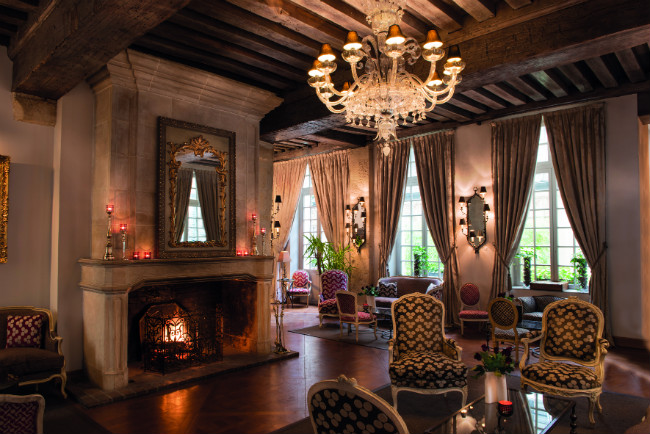
Hôtel d’Aubusson’s grand salon
When Henri IV emerged as the victor of the Wars of Religion in 1598, one of his first priorities was to rebuild the capital. With the Pont Notre-Dame dangerously overloaded, Paris needed un pont neuf (a new bridge) so he relaunched an abandoned project to connect the banks of the Seine via the western tip of Île de la Cité. The majestic, 28-metre wide construction – then the widest bridge in Europe – was inaugurated in 1607 as Pont Neuf, a symbol of a nation reborn. The only problem was that the bridge ended in the vegetable patch of the Grands-Augustins monastery, a feature of the banks of the Seine since 1293. Henry IV needed to build a road across the monks’ gardens to connect the bridge with the Left Bank, then enclosed by the Philippe Augustus wall. The monks refused. That peeved the king no end – he had already been forced to convert from Protestantism to ensure that his authority would be recognised by the Catholic-controlled city of Paris. And so he ordered the monks to give up their cabbages – or he’d open the street with canons. La rue Dauphine was opened in 1607, and was named for the dauphin, Henry IV’s son and the future Louis XIII, who was then just six years old.
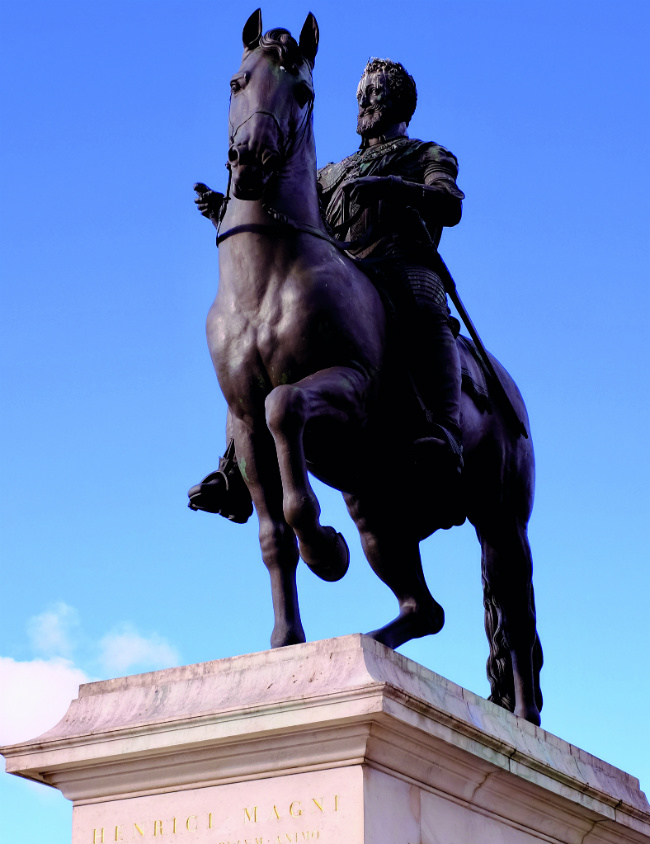
Henri IV statue, Pont Neuf. Photo: Jeffrey T Iverson
Three years later, on May 14, 1610, the dauphin was sitting through a lesson at the same Grands-Augustins monastery when news arrived that his father had just been assassinated. An engraving at 8 rue des Grands-Augustins, one street over from rue Dauphine, commemorates the very place where Louis was proclaimed the new king of France. And that’s just one of countless anecdotes linked to this storied quartier.
Across the street, at 7 rue des Grands-Augustins, stands the hôtel particulier where Picasso had his studio from 1937 to 1948. Ernest Hemingway parked his army Jeep here in 1945, during the liberation of Paris, and knocked on the door. Finding the artist away, he decided to leave a gift – a case of grenades – on which he wrote, “To Picasso from Hemingway”.
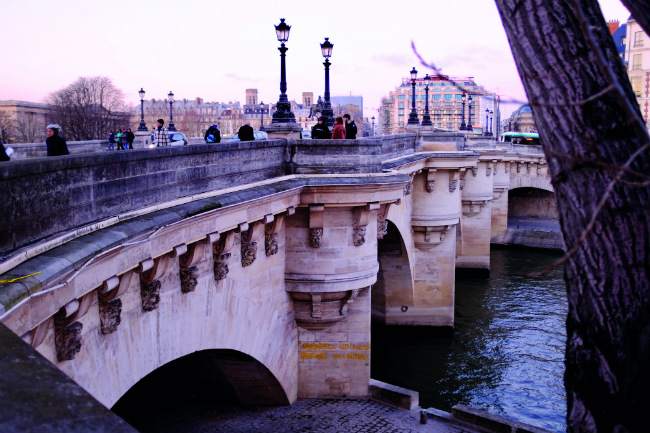
Pont Neuf. Photo: Jeffrey T Iverson
LAST VESTIGES OF AN ERA
Art and literature have long mingled here, as rue Dauphine’s lively bookstore, Couleur du Temps, reminds us. Named after a 1918 play by Guillaume Apollinaire, and located at No. 24 since 1975, it’s one of the last vestiges of an era when art publishing was the lifeblood of the neighbourhood and the rue Dauphine was lined with book wholesalers that supplied shop owners all over France.
“Traditionally, Saint-Germain has been the quintessential neighbourhood of publishers and bookstores,” says bookseller Olivier Pochard. “There are still publishers here, but many have left as the 6th has become one of the most expensive districts in Paris. And the closure of bookstores is simply devastating, and continuing.” Together, the 5th and 6th districts have lost more than 50 bookstores in the last 15 years alone.
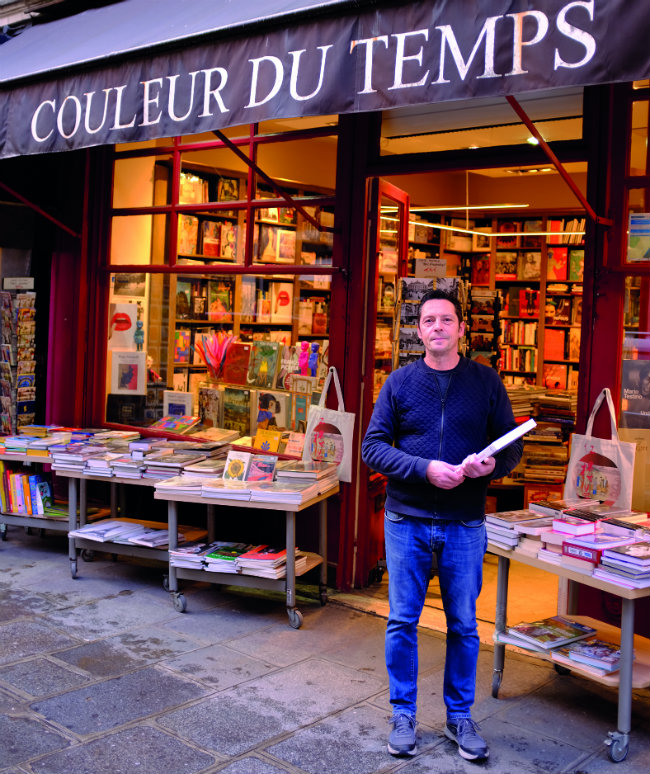
Couleur du Temps bookstore. Photo: Jeffrey T Iverson
Fortunately, Couleur du Temps seems to have a magic formula, consisting of a charming locale, low prices and a wide collection of art, photography, fashion and architecture books, including a rich selection of out-of-print titles, art prints and historic exhibition catalogues from iconic galleries like Pierre Matisse New York. Their exceptional collection is owed to a handful of wholesalers still operating in the neighbourhood, hidden away in rear courtyards. Constantly buying up small remainder stocks of new books which publishers would otherwise have shredded, Couleur du Temps lovingly gives books a second life.
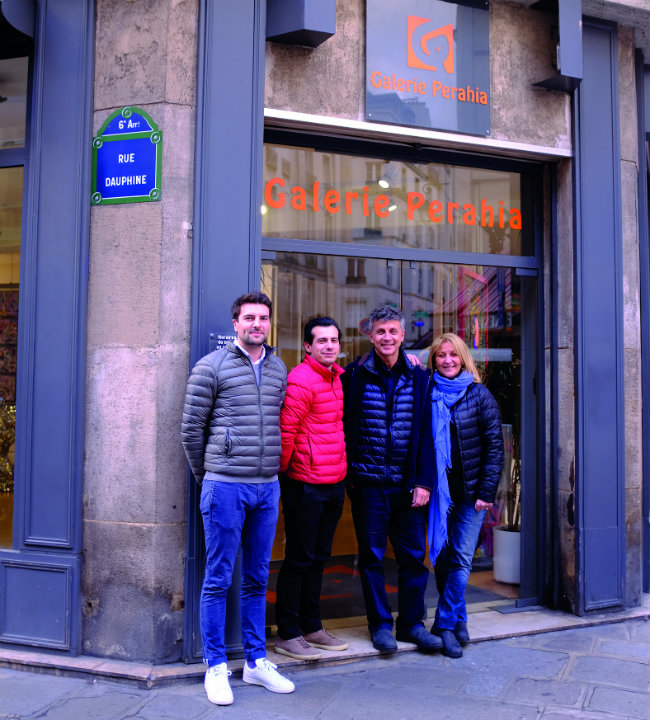
Galerie Perahia. Photo: Jeffrey T Iverson
In a similar way, a few doors up, at No. 24, Galerie Perahia has worked to inject new life and fresh ideas into the Saint-Germain-des-Prés art gallery scene. “Galleries have become so austere that people don’t dare open the door,” says Sarah Perahia, who founded the gallery in 1982 with her brother Robert. “But our founding principle was to make art accessible to the widest public possible. We have to deal with a bit of snobbery from the influential galleries of the rue de Seine, but we’re independent and we like doing things our own way.”
That means constantly evolving with the times and opening their doors to new artists and movements. Every wall of the 300m2 gallery is covered with works by both world-renowned and unknown artists of myriad styles – abstract art, hyper-realism, figuration narrative, figuration libre, kinetic art, street art – offering the visitor an explosion of colour and imagery from the moment they step through the door.
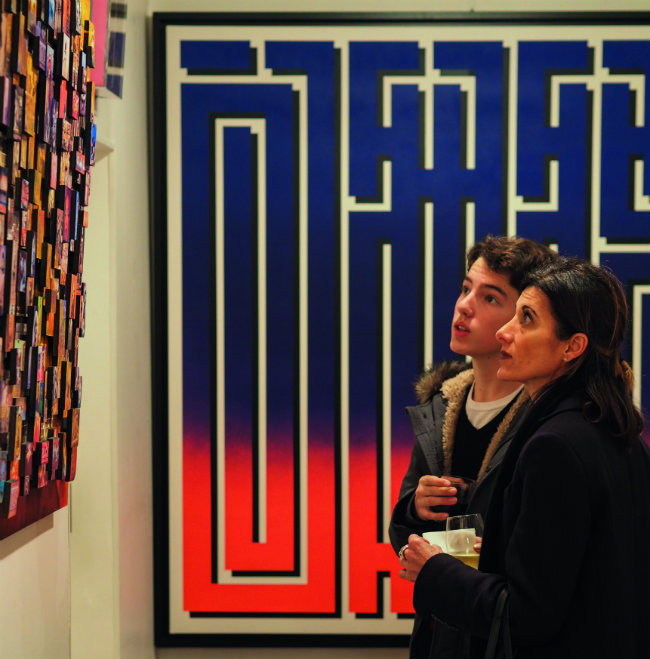
A vernissage at Galerie Perahia
Jérôme Langenieux knows about the power of colour. He helps manage the Paris boutique of Charvin, a colour manufacturer that in the 19th century furnished Cézanne and other famous painters working on the Côte d’Azur with the most exquisite paints of the day. Still today, their range of 209 oil colours represents the most extensive palette of colours in the world, and draws many an art lover into the Charvin boutique, located just around the corner from rue Dauphine, at 57 quai des Grands-Augustins.
“I think everyone is drawn to colours,” says Langenieux. “And in that respect, our boutique is like a candy shop for the eyes!” Though the boutique looks like it’s been there since the 19th century, it actually only opened in 2010. Nonetheless, Langenieux feels it’s perfectly in spirit with the quartier – one he has watched evolve since he was a child. (He grew up just over the Pont Neuf, on Île de la Cité.) “The façades of the boutiques change, as they are updated in keeping with the times,” he says, “but there is always a certain atmosphere in Saint-Germain, and I don’t think that will ever disappear. It’s in the walls and the history of the place.”
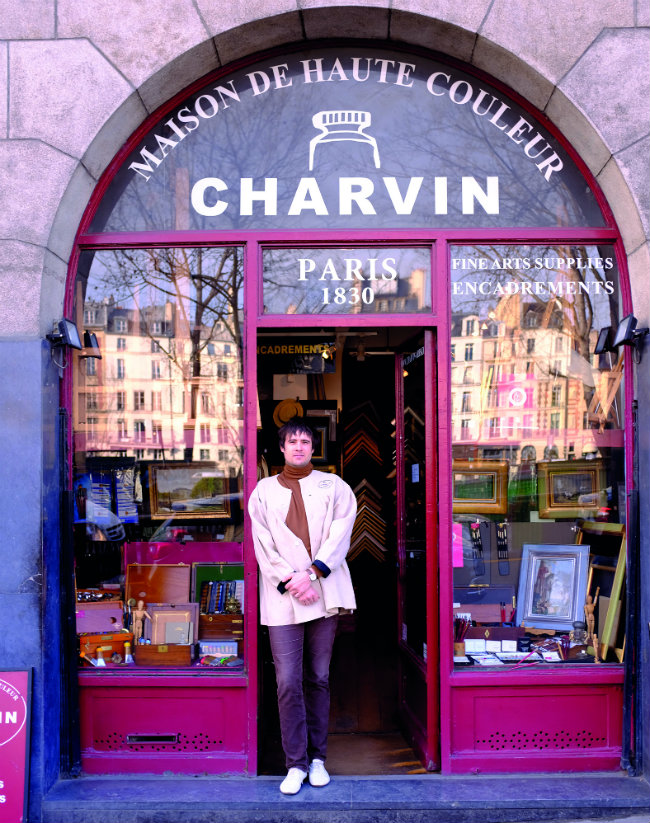
Charvin boutique at 57 quai des Grands-Augustins. Photo: Jeffrey T Iverson
TRANSPORTING POWER
Yes, perhaps some things don’t ever change. Like the appeal of a toy crafted from wood – something the legendary Paris toyshop Amuzilo has been celebrating since it first opened in 1962 at 34 rue Dauphine. Or the transporting power of simply delectable, made-from-scratch French dishes and desserts like those found at the gourmet delicatessen Maison Francart, 30 rue Dauphine, served up by Corinne, a vendeuse whose smiling face locals have known for 27 years. Or the pleasure of discovering an oasis of calm within a hidden passageway, like that of the tea house L’Heure Gourmande at 22 passage Dauphine, whose quiet and cosy ambience has been sought out for generations.
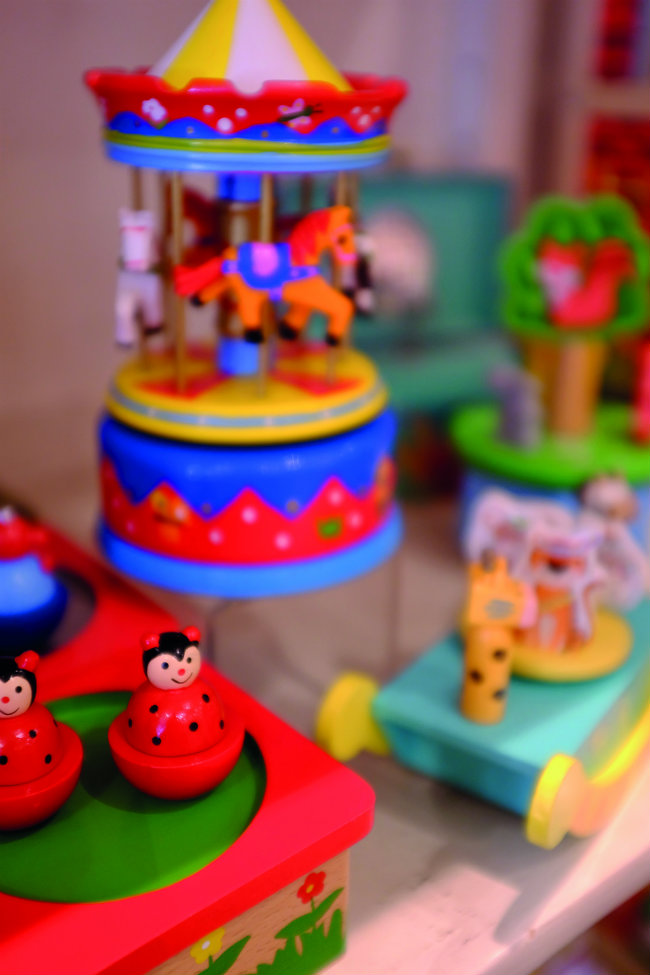
Amuzilo toy shop. Photo: Jeffrey T Iverson
Of course, rue Dauphine and Saint-Germain-des-Prés won’t ever stop evolving, but hopefully they’ll always preserve this colourful mix of the old and the new. That seems only fitting for a street overlooked by Pont Neuf – a bridge at once the oldest in Paris, yet also eternally new.
BOUTIQUES AND GALLERIES
Charvin Paris, 57 quai des Grands Augustins, Tel. +33 (0)1 43 54 98 97
Charvin Paris is the city’s only outlet of a colour manufacturer that was founded in 1830 on the Côte d’Azur and beloved by such luminaries as Cézanne, Bonnard and Ambrogiani. The Paris boutique offers a kaleidoscope of 209 oil paints – the most extensive palette of colours in the world – as well as everything from brushes and easels to pastels and notebooks. An artist’s dream.
Galerie Perahia, 24 rue Dauphine, Tel. +33 (0)1 43 26 56 21
Galerie Perahia is a different kind of Saint-Germain-des-Prés gallery: 300m2 of exhibition space filled with the vibrant colours of a diverse group of contemporary artists. It’s a gallery where works by established names – Robert Combas, Gudmundur Erro, L’Atlas, MissTic, JonOne and Richard Orlinski – hang alongside those of up-and-coming talents.
Librairie Couleur du Temps, 24 rue Dauphine, Tel. +33 (0)1 43 25 69 16
For more than 40 years, this charming bookstore has been enticing art lovers with an exceptional collection of both new and rare collectable books at low prices. Specialising in photography, design, architecture, fashion, and classic and contemporary art, they also offer a selection of children’s books, cookbooks and best-sellers.
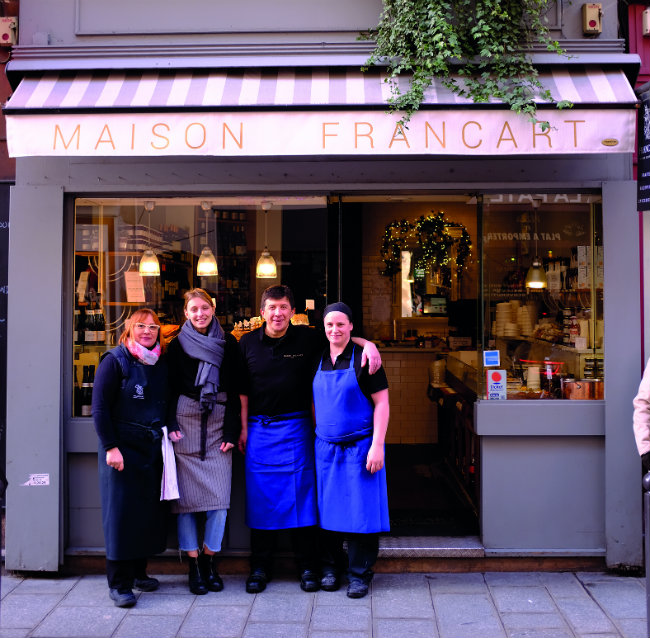
Maison Francart. Photo: Jeffrey T Iverson
Maison Francart, 30 Rue Dauphine, Tel. +33 (0)1 43 54 35 80
When Charcuterie Coesnon closed 10 years ago, the whole of Saint-Germain-des-Prés mourned– until it was reopened by the passionate chef Carine Francart as a new, equally delectable delicatessen. Francart kept on the Coesnon staff, who now serve handmade pastries, desserts and traditional French dishes for a dinner at home or a gourmet picnic by the Seine.
Café Laurent, 33 rue Dauphine, Tel. +33 (0)1 43 29 03 33
Café Laurent is much more than just the bar of the five-star Hôtel d’Aubusson: it’s a place where history and luxury combine to create an intimate and timeless ambience. In the daytime, enjoy a tea in the secluded patio garden. In the evening, step into the plush jazz lounge and take a seat at the zinc bar or relax on the sofa with a cocktail and take in a jazz trio, with concerts offered six nights a week.
Amuzilo, 34 rue Dauphine, Tel. +33 (0)1 43 54 12 70
Generations of children have romped through this iconic toyshop, opened in 1962 as the first store in Paris dedicated to wooden toys. Even today, you won’t find anything electric in the shop, but the Amuzilo has widened its repertoire to include not only wooden toys, but high-quality games, dolls and puzzles curated from all over the world – most of which you’ll find nowhere else in Paris.
From France Today magazine
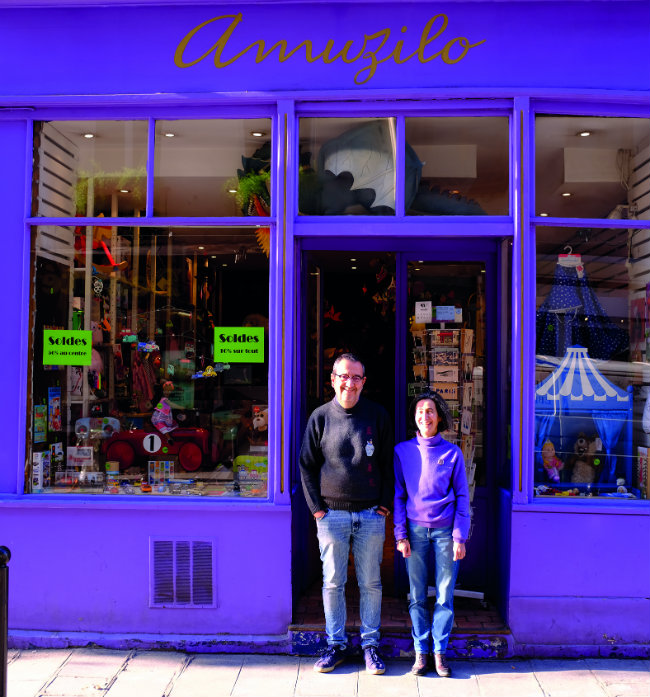
Amuzilo. Photo: Jeffrey T Iverson
Share to: Facebook Twitter LinkedIn Email
Leave a reply
Your email address will not be published. Required fields are marked *




REPLY